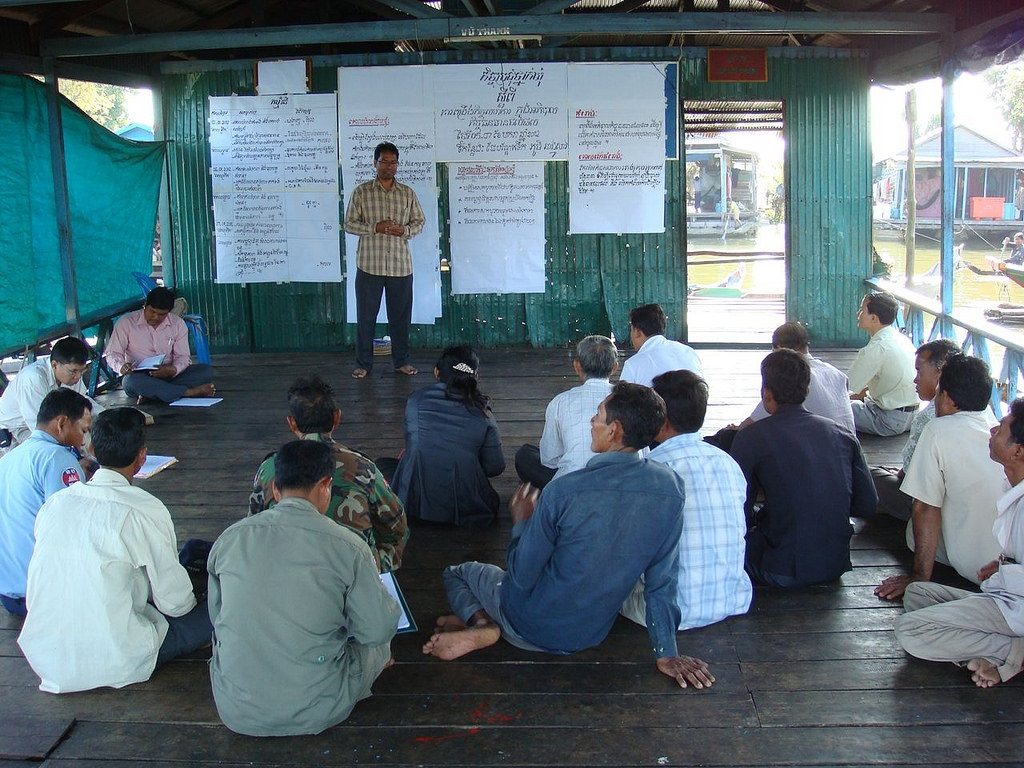
លោក អឿ អ៊ីល, នាយកប្រតិបត្តិមជ្ឈមណ្ឌលសម្រាប់ការវិភាគបញ្ហាអភិវឌ្ឍន៍ (ADIC), ជាអង្គការ NGO ក្នុងស្រុក និងជាដៃគូជាមួយអង្គការ WorldFish នៅកម្ពុជា កំពុងដឹកនាំកិច្ចពិភាក្សាក្នុងមូលដ្ឋានមួយ។ រូបភាព ដោយ WorldFish, ថតនៅថ្ងៃទី ២៧ ខែ មិថុនា ឆ្នាំ ២០១៣។ ក្រោមអាជ្ញារបណ្ណ CC BY-NC-ND 2.0។
ជំនួយពហុភាគី គឺជាមូលនិធិទាំងឡាយដែលបានប្រមែប្រមូលពីភាគីច្រើនលើសពីមួយនៅមុនពេលដែលវាត្រូវបានទៅដល់ដៃអ្នកទទួលជំនួយចុងក្រោយបង្អស់។មូលនិធិនេះត្រូវបានបង្កើត នៅពេលដែលប្រទេសមួយដែលជាម្ចាស់ជំនួយលៃលកការផ្តល់ជំនួយគាំទ្រសម្រាប់អង្គការអន្តរការីមួយ ដូចជា ធនាគារពិភពលោក និងអង្គការសហប្រជាជាតិ ដែលបង្វិលខ្ទង់ចំនាយការបរិច្ចាគទាំងនេះទៅកាន់ប្រទេសទទួលជំនួយនានា។ ភាគច្រើននៃជំនួយអភិវឌ្ឍន៍អន្តរជាតិ(IDA) ដែលបានមកពីម្ចាស់ជំនួយនានា ត្រូវបានរួមបញ្ជូលនូវ “ប្រាក់កម្ចីសម្បទាន” (ត្រូវបានកំណត់ជាប្រាក់កម្ចី “ដែលមានភាពអនុគ្រោះខ្លាំងជាងកម្ចីនានានៅលើទីផ្សារ។ ការធ្វើសម្បទាន គឺត្រូវបានសម្រេចទាំងក្នុងករណីអត្រាការប្រាក់ទាបជាងអត្រាលើទីផ្សារ ឬ អំឡុងពេលអនុគ្រោះ” រយៈពេល ១០ឆ្នាំ ឬយូរជាងនេះ ឬលក្ខខណ្ឌរួមទាំងពីរ)1 និង “កម្ចីមិនសម្បទាន” (កម្ចីក្រៅពីលំនាំដែលលើកឡើងខាងលើ) និង “ជំនួយបច្ចេកទេស” (ជំនួយបច្ចេកទេស គឺជាការចំនាយដោយម្ចាស់ជំនួយលើអ្នកប្រឹក្សា ការបណ្តុះបណ្តាល និងស្រាវជ្រាវ)។2
ប្រហែល ៥០ភាគរយនៃជំនួយអន្តរជាតិដែលផ្តល់មកឱ្យកម្ពុជា គឺជាជំនួយពហុភាគី (មានចំនួន ២៨៦,៦៥០,៦៣៩ ដុលា្លរ បើធៀបទៅនឹងចំនួនថវិការជំនួយសរុប៨១៧,៥៦៥,៧៥១ ដុល្លារ ក្នុងឆ្នាំ ២០១៥ និងទទួលបានចំនួន ៤៥៦,៩៤៨,៦៤១ ដុល្លារ ធៀបជាមួយនឹងចំនួនដែលគ្រោងទុក ១,០៣៩,៤៨០,២៩២ ដុល្លារ សម្រាប់ឆ្នាំ ២០១៦)។3 សហភាពអឺរ៉ុប និងអង្គការសហប្រជាជាតិស្ទើរតែផ្តល់ឱ្យកម្ពុជាទាំងស្រុងក្នុងទម្រង់ជំនួយឥតសំណង។4 ជំនួយទាំងនេះត្រូវបានផ្តល់ឱ្យជាអាទិភាពទៅបណ្តាអង្គការមិនមែនរដ្ឋាភិបាល ដែលមានភាពស្រដៀងគ្នាច្រើនទៅនឹងជំនួយទ្វេភាគី ដូចដែលបានបង្ហាញនៅក្នុងទំព័រជំនួយទ្វេភាគី វាមានរបៀបវារៈច្បាស់លាស់សម្រាប់ប្រភេទនៃគម្រោងដែលម្ចាស់ជំនួយទាំងពីរនេះផ្តល់មូលនិធិទៅឱ្យ។
ការសិក្សាស្រាវជ្រាវមួយនៅក្នុងវិស័យនេះបង្ហាញថា ផលប្រយោជន៍នយោបាយរបស់ភាគីពាក់ព័ន្ធសំខាន់ៗរបស់អង្គការ ពិតជាមានឥទ្ធិពលលើការបែងចែកថវិកាជំនួយពហុភាគី។5 ជាឧទាហរណ៍ ធនាគារពិភពលោក បានកាត់ផ្តាច់មូលនិធិរបស់ខ្លួនអស់រយៈពេលប្រមាណ ៥ឆ្នាំ ដោយសារតែសំពាធមកពីអ្នកឧបត្ថម្ភធនាគារនេះ ហើយមូលនិធិបានបន្តជាថ្មីម្តងទៀតដោយយោងលើផលប្រយោជន៍នយោបាយ។
ជំនួយពហុភាគី អាចនឹងត្រូវបានប្រមែប្រមូលបានតាមមធ្យោបាយពីរយ៉ាង៖ ផ្តល់ឱ្យដោយផ្ទាល់ដល់ប្រទេសទទួលជំនួយ ឬដល់អង្គការមិនមែនរដ្ឋាភិបាលណាមួយ ដែលនឹងប្រកួតប្រជែងគ្នាតាមរយៈការសរសេរសុំជំនួយដើម្បីទទួលបានថវិកានោះ។ ជាឧទាហរណ៍ នៅក្នុងឆ្នាំ ២០១៥ ទឹកប្រាក់ចំនួន ២៨៦,៦៥០,៦៣៩ ដុល្លារ ត្រូវបានផ្តល់ជាជំនួយអភិវឌ្ឍន៍អន្តរជាតិ(IDA) ក្នុងទម្រង់ពហុភាគី ដែលក្នុងនោះទឹកប្រាក់ចំនួន ១៣,៦៦៤,៦៤៩.៩២ ដុល្លារ ត្រូវបានផ្តល់ទៅឱ្យអង្គការមិនមែនរដ្ឋាភិបាលនានាដែលកំពុងដំណើរការនៅក្នុងប្រទេសកម្ពុជា។6
ម្ចាស់ជំនួយពហុភាគីធំៗនៅកម្ពុជា
- ធនាគារអភិវឌ្ឍន៍អាស៊ី (ADB)
- ធនាគារអភិវឌ្ឍន៍ចិន
- មូលនិធិរូបិយវត្ថុអន្តរជាតិ (IMF)
- ធនាគារពិភពលោក
- អង្គការសហប្រជាជាតិ (UN) ( និង នាយកដ្ឋានរងនានារបស់ UN)
ខណៈដែលជំនួយពហុភាគីដ៏ច្រើនបានមកពី មូលនិធិដោយរដ្ឋាភិបាល ឬកម្មវិធីឧបត្ថម្ភនានា ភាគច្រើននៃជំនួយទាំងនោះ ជានាដការឯករាជ្យដែលលើកកម្ពស់ដល់ការអភិវឌ្ឍនៅក្នុងវិស័យជាក់លាក់។ ជាឧទាហរណ៍ កម្មវិធីបង្កើនថាមពលកកើតឡើងនៅបណ្តាប្រទេសចំណូលទាប (SREP) – ដែលជាគោលបំណងមួយនៃមូលនិធិការវិនិយោគអាកាសធាតុសកល ដែលបានបរិច្ចាកថវិកាចំនួន ៣០ លានដុល្លារ ដល់រាជរដ្ឋាភិបាលកម្ពុជា នៅថ្ងៃ អង្គារ ទី ២១ ខែ មិថុនា ឆ្នាំ ២០១៦ ដើម្បីប្រើប្រាស់ផ្តាច់មុខលើហេដ្ឋារចនាសម្ព័ន្ធថាមពលព្រះអាទិត្យ។7
ប្រភេទគម្រោងទាំងនេះ ជាញឹកញាប់ត្រូវបានបញ្ជូលទៅជា កិច្ចព្រមព្រៀងសហប្រតិបត្តិការ ដោយយល់ឃើញថា ម្ចាស់ជំនួយមួយ (ច្រើន) មានការលើកជាលក្ខខណ្ឌមួយចំនួនទៅលើថវិកាដែលត្រូវបានចំនាយ។ នៅក្នុងករណីខាងលើនេះ ថវិកានឹងត្រូវបានចំនាយលើថាមពលស្អាត។ ជំនួយបែបនេះ គឺត្រូវបានរំពឹងថា នឹងថយចុះបន្តិចម្តងៗនៅឆ្នាំបន្តបន្ទាប់ដោយសារការរឹតចំនងកាន់តែខ្លាំងរបស់រាជរដ្ឋាភិបាលនឹងធនាគារក្នុងតំបន់ និងប្រជាជាតិម្ចាស់ជំនួយ។ ការវិនិយោគត្រូវបានរំពឹងថានឹងនាំប្រភពធនធានមកពីក្រុមហ៊ុនបរទេស ហើយជាពិសេសតំបន់សេដ្ឋកិច្ចពិសេស។
ជំនួយបច្ចេកទេស (TA) ក៏ជាការផ្តោតសំខាន់មួយនៃជំនួយពហុភាគីផងដែរ។ គម្រោងជំនួយបច្ចេកទេស (TA) ត្រូវបានរៀបចំឡើងទៅតាមរបៀបដែលដៃគូអភិវឌ្ឍន៍ផ្តល់ការគាំទ្រ និងការប្រឹក្សាយោបល់ឱ្យទៅកាន់រដ្ឋាភិបាល។ ឧទាហរណ៍មួយចំនួននៃគម្រោងទាំងនេះរួមមាន៖ សុខភាពអនាម័យនៅទីជនបទ8 (គាំទ្រដោយ ធនាគារពិភពលោក), ការបង្កើតគ្រឹះស្ថានមីក្រូហិរញ្ញវត្ថុ9 (គាំទ្រដោយ ធនាគារអភិវឌ្ឍន៍អាស៊ី), វគ្គបណ្តុះបណ្តាលខ្លីៗកម្ពុជា-សឹង្ហបុរី10 និងគ្រោងការសកម្មភាពសហប្រតិបត្តិការបច្ចេកទេស11 (គាំទ្រដោយ មូលនិធិរូបិយវត្ថុអន្តរជាតិ (IMF))។
ធ្វើបច្ចុប្បន្នភាពចុងក្រោយ៖ ថ្ងៃទី ២២ ខែ មិថុនា ឆ្នាំ ២០១៦។
ទាក់ទងនឹងជំនួយអភិវឌ្ឍន៍ពហុភាគី
- ជំនួយអភិវឌ្ឍន៍ទ្វេភាគី
- គោលនយោបាយអភិវឌ្ឍន៍ និងការគ្រប់គ្រង
- សេដ្ឋកិច្ច និងពាណិជ្ជកម្ម
- ទំនាក់ទំនងអន្តរជាតិ
ឯកសារយោង
- 1. មូលនិធិរូបិយវត្ថុអន្តរជាតិ (IMF), ២០០៣, “ស្ថិតិបំណុលខាងក្រៅ: សេចក្តីណែនាំសម្រាប់អ្នកចងក្រង និងអ្នកប្រើប្រាស់.” ឧបសម្ព័ន្ធ ៣។ http://unstats.un.org/unsd/nationalaccount/docs/External_debt_statistics_guide.pdf
- 2. ActionAid. “ជំនួយជាក់ស្តែង II: សារគន្លឹះ, ការពិត និង ស្ថិតិ.” ចូលអានថ្ងៃទី ២៩ ខែមិថុនា ឆ្នាំ២០១៦។ https://www.actionaid.org.uk/sites/default/files/doc_lib/real-aid-findings-summary.pdf
- 3. ក្រុមប្រឹក្សាអភិវឌ្ឍន៍កម្ពុជា (CDC). ទិន្នន័យ ODA របស់ប្រទេសកម្ពុជា. “ខ្ទង់ចំនាយផ្លូវការរបស់ ODA.” http://cdc.khmer.biz/index.asp
- 4. ជំនួយអភិវឌ្ឍន៍អន្តរជាតិ (IDA). ២០០២. ជំនួយឥតសំណង និងរចនាសម្ព័ន្ធជំនួយការអភិវឌ្ឍន៍ផ្លូវការ. ចូលអាននៅថ្ងៃទី ២៨ ខែ មិថុនា ឆ្នាំ ២០១៦។ http://documents.worldbank.org/curated/en/998091468779994153/pdf/264620Grants0and0structure07.pdf
- 5. . Dreher, A., Sturm, J.-E., និង Vreeland, J. R. (2009a). ជំនួអភិវឌ្ឍន៍ និងនយោបាយអន្តរជាតិ: តើភាពជាសមាជិកនៅក្រុមប្រឹក្សាសន្តិសុខអង្គការសហប្រជាជាតិមានឥទ្ធិពលលើការសម្រេចចិត្តរបស់ធនាគារពិភពលោកដែរ ឬទេ?. ទិនានុប្បវត្តិនៃការអភិវឌ្ឍសេដ្ឋកិច្ច, 88 (1), 1-18. Dreher, A., Sturm, J.-E., និង Vreeland, J. R. (2009b). Global Horse Trading: មូលនិធិរូបិយវត្ថុអន្តរជាតិ (IMF) ផ្តល់ប្រាក់កម្ចីសម្រាប់ការបោះឆ្នោតនៅក្រុមប្រឹក្សាសន្តិសុខអង្គការសហប្រជាជាតិ. European Economic Review, 53 (7), 742-757.
- 6. ក្រុមប្រឹក្សាអភិវឌ្ឍន៍កម្ពុជា (CDC). ទិន្នន័យ ODA របស់កម្ពុជា។ http://cdc.khmer.biz/index.asp
- 7. Kali Kotoski. “វិស័យថាមពលកកើតឡើងវិញទទួលបានមូលនិធិ ៣០ លានដុល្លារ.” កាសែតភ្នំពេញប៉ុស្តិ៍, ចុះថ្ងៃទី ២១ ខែ មិថុនា ឆ្នាំ ២០១៦។ ចូលអានថ្ងៃទី ២២ ខែ មិថុនា ឆ្នាំ ២០១៦។ https://www.phnompenhpost.com/business/renewables-receive-30m-funding-boost
- 8. កូវ ភិរម្យ. កម្មវិធីអនាម័យ និងទឹកស្អាតធនាគារពិភពលោក (WSP). ២០១៥. “របាយការណ៍សង្ខេបស្តីពីជំនួយការបច្ចេកទេស P132201: ទីផ្សារអនាម័យនៅកម្ពុជា.” http://www-wds.worldbank.org/external/default/WDSContentServer/WDSP/IB/2015/04/30/090224b082e294f0/1_0/Rendered/PDF/Synthesis0repo0sanitation0marketing.pdf
- 9. ធនាគារអភិវឌ្ឍន៍អាស៊ី (ADB). ២០០៥. ជំនួយបច្ចេកទេសនៅព្រះរាជាណាចក្រកម្ពុជា: ការអភិវឌ្ឍសេវាកម្មប្រាក់បញ្ញើរនៅទីជនបទក្នុងប្រទេសកម្ពុជា។ https://www.findevgateway.org/paper/2005/12/technical-assistance-kingdom-cambodia-developing-deposit-services-rural-cambodia
- 10. កម្មវិធីសហប្រតិបត្តិការសឹង្ហបុរី (SCP). កម្មវិធី IAI. វគ្គបណ្តុះបណ្តាលខ្លីៗកម្ពុជា-សឹង្ហបុរី ។ https://www.scp.gov.sg/content/scp/iai_programmes/cambodia-singaporetrainingcompendium.html
- 11. មូលនិធិរូបិយវត្ថុអន្តរជាតិ (IMF). 2003. ជំនួយការបច្ចេកទេស IMF: ការផ្លាស់ប្តូរចំនេះដឹងការអនុវត្តល្អបំផុត។ https://www.imf.org/external/pubs/ft/exrp/techass/techass.htm

